As winter approaches and temperatures drop, many animals seek shelter and enter a state of hibernation. But what about our tiny, colorful friends, the tree frogs? Are they also tucked away in a cozy corner, snoozing through the colder months?
The answer is yes, tree frogs do hibernate! These fascinating creatures have developed unique adaptations to survive harsh winters. Tree frogs enter a state called brumation, which is similar to hibernation but unique to cold-blooded animals. During this time, they drastically reduce their metabolic rate and find secure hiding spots to wait out the cold. Some species can even survive being partially frozen!
Curious to learn more about these resilient little amphibians? In this article, I will try to gather all the necessary information you need to know about tree frogs’ hibernation, exploring their survival strategies and the remarkable ways they endure the winter season.
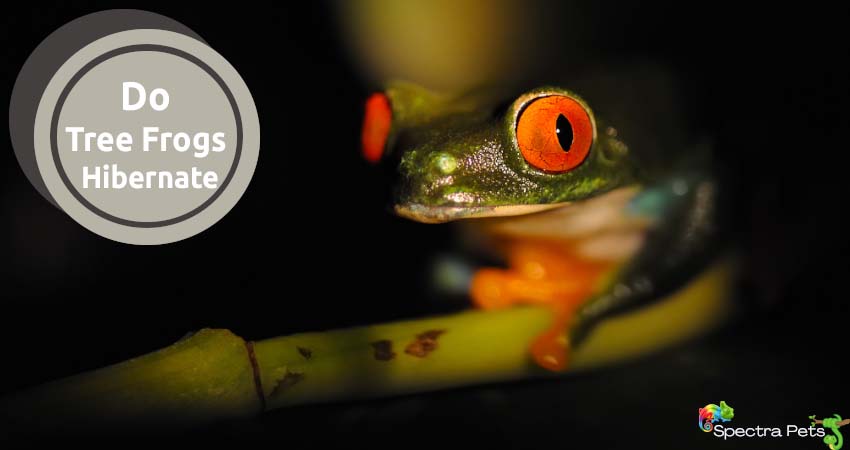
What is hibernation?
When you consider the various ways in which animals can adapt to environmental changes in order to survive, you can see how amazing nature truly is. One such tactic is hibernation. The Tree Frogs have the ability to survive and adapt to the weather conditions just as well.
Tree frogs living in harsh, cold weather conditions usually go into hibernation to slow down their metabolism and ensure their longevity. However, some of them, such as those living in tropical hot lands, do not hibernate because there is no need to do so.
The process of hibernation involves the animal’s metabolism being slowed down to the point where it consumes very little energy; even its heart rate and body temperature are reduced, and it usually doesn’t eat. This is something that many animals do, including bears, jumping mice, turtles, snakes, and even a lot of insects that hibernate during the winter.
Reptiles and amphibians, which are cold-blooded animals (unable to generate their own body heat using their metabolism), must hibernate during winter because it is far too cold for them to be active without freezing to death. They must make sure they locate the ideal location if they are to survive this challenging season.
How long do tree frogs hibernate?

Tree frogs hibernate in order to survive the cold. If the outside temperature falls below the freezing point, their body temperatures will also drop below the freezing point.
These anurans hibernate for several days, weeks, or even months. They typically enter hibernation as soon as the temperature drops below freezing.
When the snow starts to melt in the winter, it is time for these amphibians to come out of hibernation. In addition, they frequently come out of hibernation after rain. After all, the temperature must be just right for them to survive in the wild. In light of this, until the temperature in their environment is suitable for them, these amphibians continue to hibernate.
At what temperature do tree frogs hibernate?
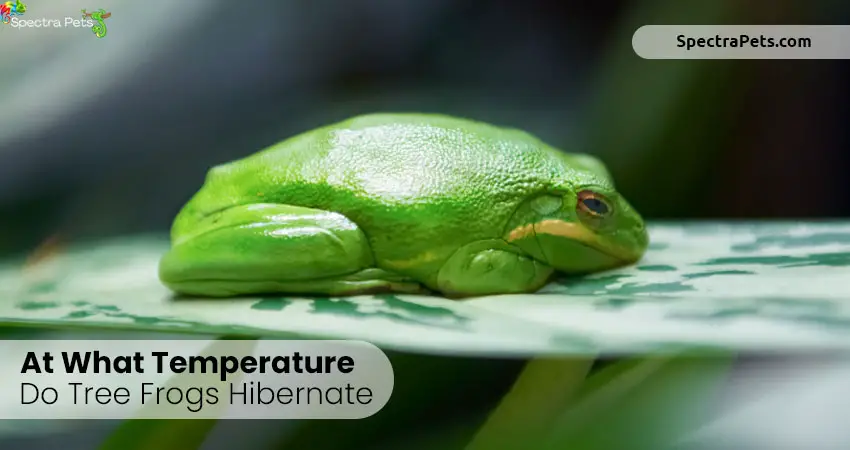
For tree frogs, the ideal temperature ranges between 18°C and 30°C. Some species can even survive temperatures as high as 41°C.
Tree frogs usually go into hibernation when the temperature falls below 18°C. -6°C is the lowest temperature at which a typical tree frog can survive. Some specific species, such as the Northern American Tree Frog can even survive -7°C.
How do tree frogs survive winter?

During winter, tree frogs go through a lot of changes to ensure their survivability.
They typically burrow into the ground, safely below the frost line. Some varieties of tree frogs are not particularly skilled diggers. Some of their favorite spots to hide during hibernation are trees, inside the cracks of logs or wooden blocks, etc.
For survival, these amphibians hibernate during the winter by freezing 40% to 65% of their body water content. Their blood glucose levels rise in the winter while their breathing and heart stop. But once the temperature rises above freezing, they regain consciousness.
Not to mention that during their winter hibernation, tree frogs undergo significant changes. Let’s learn more about them as we go…
Frost Resistance
Due to their eco-thermic nature, tree frogs’ body temperatures are heavily influenced by their environment. They typically freeze into a block of ice when the temperature drops, as is customary. It could be the cause of their death. But, due to their anti-freezing properties, these issues do not arise.
The liver of tree frogs begins working its magic when the temperature drops to the point where everything becomes frozen. Their liver starts converting the stored glycogen (sugar) into glucose. As a result, the bloodstream carries the sugar to all of the frog’s body tissues. This procedure, therefore, stops the cells from drying out.
By acting as natural frost resistance, the elevated glucose prevents the tissues from freezing. Consequently, these amphibians can endure the winter without freezing to death while hibernating.
Slow Metabolism
Tree frogs that are hibernating can survive the winter thanks to their slow metabolism.
In the winter, tree frogs go through an amazing adaptation that causes them to slow down their metabolism. Therefore, their metabolic rate drastically decreases during hibernation, and they survive the entire winter using very little energy. Because of this, these amphibians don’t need to eat to fulfill their hunger.
Cutaneous Respiration
Tree frogs will need to take in more oxygen if they continue to breathe by diffusion. Not to mention that they will find it challenging during the winter.
During hibernation, cutaneous respiration is the only method of breathing for frogs. So their cutaneous respiration can be considered an additional winter survival strategy.
These anurans need relatively little oxygen in cold weather due to cutaneous respiration. This is how cutaneous respiration aids them in obtaining the necessary oxygen for a prolonged period of time through their moist skin.
Therefore, these guys can easily hibernate at subfreezing temperatures thanks to cutaneous respiration.
Low Heart Rate
In order to survive the winter, tree frogs’ bodies adjust by lowering their heart rate while they are hibernating.
Frogs that are partially frozen occasionally experience heart failure. As a result, hibernating frogs almost seem to be dead. Some tree frogs do, however, continue to beat their hearts. They just slow it down.
The researchers found astounding heart rate variations between an active tree frog and one that is hibernating. A hibernating tree frog has a heart rate of 21.9/min as opposed to an active tree frog’s heart rate of 60.8/min. As a result, during hibernation, the heart rate slows by half. The rise and fall in temperature have a significant impact on this. When the temperature drops, their hearts beat more slowly.
A slower metabolism is correlated with a slower heart rate. Tree frogs’ hearts beat more slowly, which causes them to burn calories more slowly. They can thus conserve their energy.
Where do tree frogs hibernate?
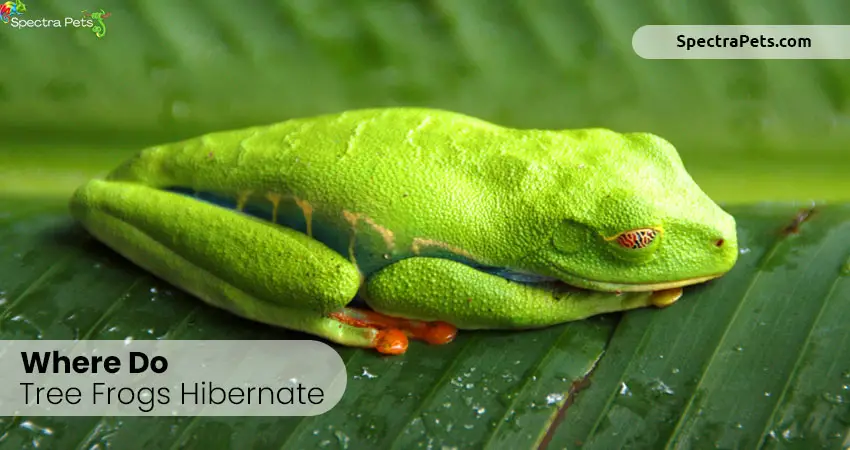
In the Northern Hemisphere, tree frogs typically hibernate during the colder months in regions with severe winters. When hibernating, North American tree frogs like the Spring Peeper and Wood Frog can withstand freezing temperatures as low as -40°C.
Frogs have cold blood, so their temperature changes depending on their surroundings. Despite their ability to withstand the cold, they must hibernate in order to survive below a certain temperature. A frog will probably perish if it is not prepared for the cold.
This is particularly true for toads, who cannot endure winter temperatures comparable to those of tree frogs without burrowing below the frost line. This explains why the majority of frog species live year-round in rainforests with warm, muggy climates.
As winter draws near, tree frogs hibernate because the cold prevents them from being active. They can quickly perish if exposed to temperatures below freezing. In order to survive the cold, these creatures search for shelter and go into a state that I will explain below.
1. Tree frogs spend winter under leaf litter
In the winter, many types of tree frogs hibernate and seek protection and warmth under leaf litter. The perfect place for them to hibernate during the chilly winter months is in leaf litter, which is made up of fallen leaves, pine needles, and soil.
Falling leaves are typically a sign for these amphibians to get ready for the winter in the autumn. The good news is that the leaves fall provides them with the natural shelter they require during the winter. Since tree frogs live in the forest and in trees, leaves are a natural component of their habitat.
When leaves fall during the autumn, they typically remain there for the rest of the winter unless they are purposefully picked up. Therefore, it is best to leave the leaf litter alone if these frogs are common in your backyard so they can find shelter during the winter.
The Gray Tree Frog, Cope’s Gray Tree Frog, Spring Peeper, and Wood Frog are a few of the more prevalent tree frogs that hide during the winter under leaf litter.
2. Tree frogs spend winter in tree hollows
Despite the fact that they can find adequate shelter on the ground, tree frogs prefer to stay on land during the winter. There are still some species that prefer to seek refuge in tree hollows. These locations, which include holes or hollowed-out tree parts, can be found higher up in the trees as well as closer to the ground.
Some trees frequently have holes or hollow spaces close to the ground that these arboreal species can easily access. In fact, some tree frog species regularly reside in tree hollows whether or not it is winter. Therefore, when the weather outside becomes a little too cold, a frog who is fortunate enough to already reside in a tree hollow may choose not to even leave.
Tree frogs may avoid them because other tree-dwelling animals, like squirrels or birds, which may eat these amphibians, also make use of hollows found in higher parts of trees. When a tree frog hibernates in the winter, it is completely defenseless, so it tends to be safer to hide on the ground beneath leaf litter or beneath exposed tree roots that are covered in snow.
3. Tree frogs spend winter under tree roots
Tree frogs also often spend the winter under exposed tree roots. When a tree reaches a certain size, its exposed roots can shoot upward and then downward again. Because the larger roots offer more protection from the elements, they may choose to simply hide there during the winter.
Regardless of whether it is winter or not, some of these amphibians remain under exposed tree roots the rest of the year. They spend the majority of the day hiding out in these tree roots, emerging at night to hunt and eat insects. A tree frog may not need to travel far to find a suitable location to hibernate during the winter if it already has a reliable tree root to hide beneath.
Do tree frogs hibernate in captivity?
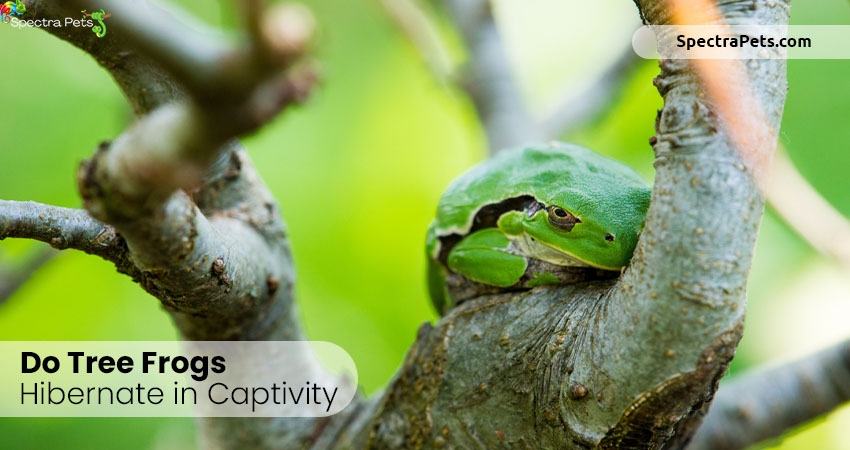
Typically, wild tree frog species hibernate. They burrow beneath the soil’s frost line as the temperature drops around them.
Tree frogs are unable to sense sharp drops in temperature because their owners are able to keep the terrarium’s temperature within the ideal range. These creatures, therefore, don’t feel the need to slow down. In other words, these amphibians will hibernate in captivity if you allow them to feel the cold.
However, in order to maintain their original characteristics, you should assist your pet frogs in hibernating.
Read More: Habitat Setup Guide
Do tree frogs look dead while hibernating?
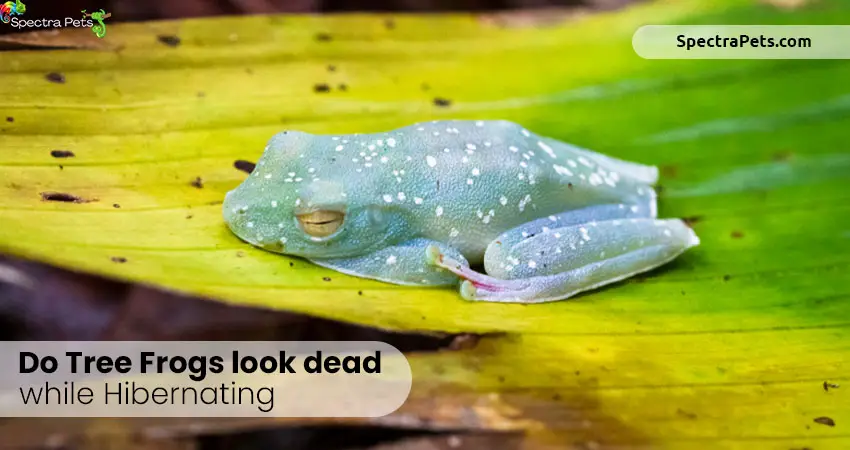
People occasionally mistakenly believe a tree frog that is hibernating is dead.
Tree frogs in hibernation appear to be dead. This is because they become completely still during this period. In addition, these amphibians don’t react to your touch in any way. However, you need to be aware of the distinctions between the symptoms of hibernation and a dead tree frog. Never assume they are dead while hibernating.
When do tree frogs come out of hibernation?

Since tree frogs hibernate during the winter, it makes sense to assume that they will emerge in the spring. However, they do not begin emerging from hibernation until later in the spring. Early in the spring, the weather is still chilly, making it dangerous for these amphibians to awaken.
They slowly emerge from hibernation in the early spring as the snow begins to melt. After a springtime downpour, you can see them coming out of hibernation.
After an early warm stretch, these amphibians will tragically perish if they emerge from hibernation too soon. This incident is known as the “frog winter-killing”.
Summary
Some species of tree frogs need an adequate temperature to ensure survivability. In order to defend themselves from harsh weather conditions, these creatures choose hibernation. Some species of these amphibians don’t need to do this, as they live in humid conditions and don’t require it to survive cold weather.
There are many endangered species of frogs that lose their lives during the hibernation period. If you have a pet tree frog, you should regulate the temperature in the terrarium to favorable conditions for your pet, as hibernation is only beneficial to it.
